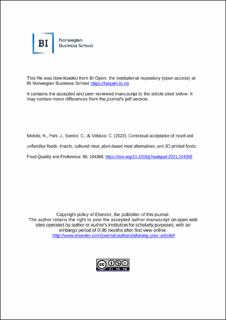| dc.description.abstract | Engineering healthy diets from sustainable food resources undoubtedly constitutes a major global challenge. One solution to the problem of developing healthy and sustainable diets involves the incorporation of various novel/unfamiliar foods into our diets (e.g., insect-based foods, cultured meats, plant-based meat alternatives, and 3D printed foods). However, the consumer acceptance of novel/unfamiliar foods still poses something of a challenge. Although a growing body of research has started to reveal that situational factors (e.g., social companions, eating venue) can influence food preferences, it remains unclear how exactly they influence the consumer’s acceptance of novel/unfamiliar foods (including unfamiliar ingredients, food produced by novel processes/technologies). Across three studies, we examined the influence of social companions (alone, friend, family, acquaintance, partner) and venue (home, cafe, bar, pub, food festival, restaurant), on the anticipated willingness to try a number of novel/unfamiliar foods (insect-based foods, cultured meats, plant-based meat alternatives, and 3D printed foods). Using the category name and descriptions of novel/unfamiliar foods, our results demonstrate that situational factors influence anticipated acceptance differently depending on the type of novel/unfamiliar foods. Eating with friends and at food festivals plays an important role in the anticipated acceptance of insect-based foods, cultured meats, and 3D printed foods in a similar way. Moreover, expected positive and negative emotions might help to explain why these situational factors increase the anticipated acceptance of these foods. In contrast, the environmental situations that increase the anticipated acceptance of plant-based meat alternatives are similar to those increasing the acceptance of typical (rather than novel) foods. Taken together, these findings reveal the role of situational factors in the anticipated eating of a variety of novel/unfamiliar foods, thus providing practical implications on how/where to introduce such foods or engineer appropriate situations to increase the acceptance of, and exposure to, such novel/unfamiliar foods. | en_US |

